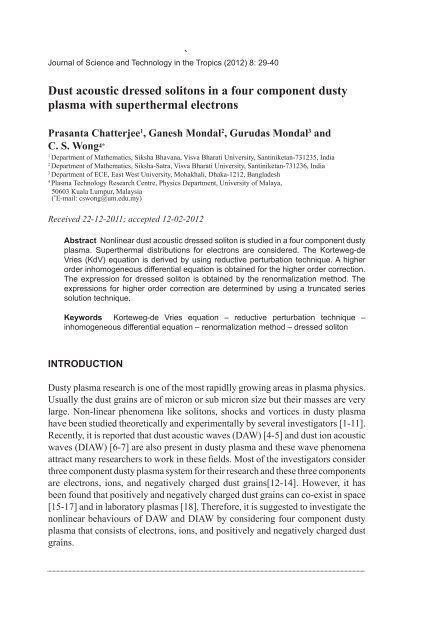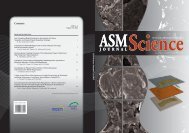Download - Akademi Sains Malaysia
Download - Akademi Sains Malaysia
Download - Akademi Sains Malaysia
Create successful ePaper yourself
Turn your PDF publications into a flip-book with our unique Google optimized e-Paper software.
Journal of Science and Technology in the Tropics (2012) 8: 29-40<br />
Journal of Science and Technology in the Tropics 29<br />
Dust acoustic dressed solitons in a four component dusty<br />
plasma with superthermal electrons<br />
Prasanta Chatterjee 1 , Ganesh Mondal 2 , Gurudas Mondal 3 and<br />
C. S. Wong 4*<br />
1<br />
Department of Mathematics, Siksha Bhavana, Visva Bharati University, Santiniketan-731235, India<br />
2<br />
Department of Mathematics, Siksha-Satra, Visva Bharati University, Santiniketan-731236, India<br />
3<br />
Department of ECE, East West University, Mohakhali, Dhaka-1212, Bangladesh<br />
4<br />
Plasma Technology Research Centre, Physics Department, University of Malaya,<br />
50603 Kuala Lumpur, <strong>Malaysia</strong><br />
( * E-mail: cswong@um.edu.my)<br />
Received 22-12-2011; accepted 12-02-2012<br />
Abstract Nonlinear dust acoustic dressed soliton is studied in a four component dusty<br />
plasma. Superthermal distributions for electrons are considered. The Korteweg-de<br />
Vries (KdV) equation is derived by using reductive perturbation technique. A higher<br />
order inhomogeneous differential equation is obtained for the higher order correction.<br />
The expression for dressed soliton is obtained by the renormalization method. The<br />
expressions for higher order correction are determined by using a truncated series<br />
solution technique.<br />
Keywords Korteweg-de Vries equation – reductive perturbation technique –<br />
inhomogeneous differential equation – renormalization method – dressed soliton<br />
INTRODUCTION<br />
Dusty plasma research is one of the most rapidlly growing areas in plasma physics.<br />
Usually the dust grains are of micron or sub micron size but their masses are very<br />
large. Non-linear phenomena like solitons, shocks and vortices in dusty plasma<br />
have been studied theoretically and experimentally by several investigators [1-11].<br />
Recently, it is reported that dust acoustic waves (DAW) [4-5] and dust ion acoustic<br />
waves (DIAW) [6-7] are also present in dusty plasma and these wave phenomena<br />
attract many researchers to work in these fields. Most of the investigators consider<br />
three component dusty plasma system for their research and these three components<br />
are electrons, ions, and negatively charged dust grains[12-14]. However, it has<br />
been found that positively and negatively charged dust grains can co-exist in space<br />
[15-17] and in laboratory plasmas [18]. Therefore, it is suggested to investigate the<br />
nonlinear behaviours of DAW and DIAW by considering four component dusty<br />
plasma that consists of electrons, ions, and positively and negatively charged dust<br />
grains.

















